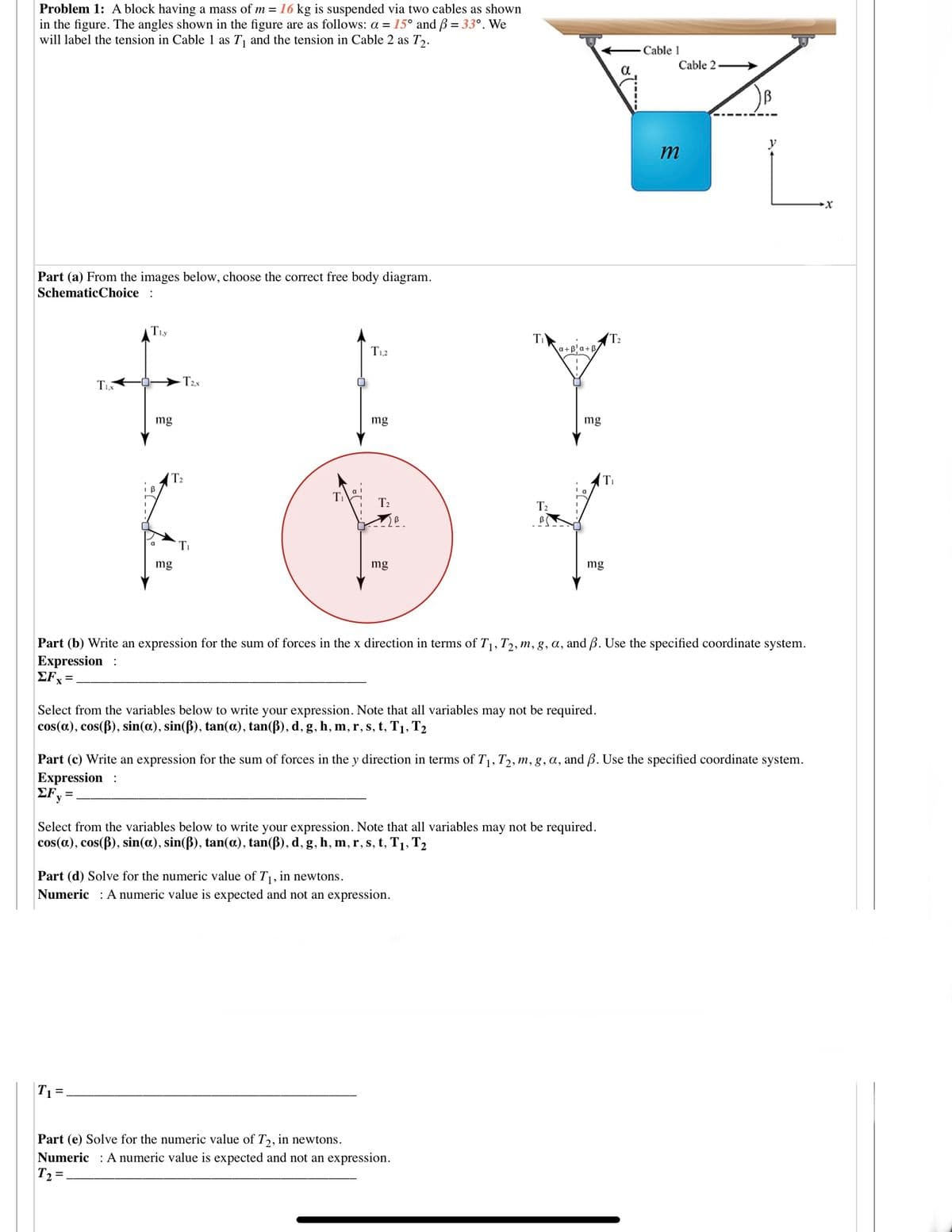Problem 1: A block having a mass of m = 16 kg is suspended via two cables as shown in the figure. The angles shown in the figure are as follows: a = 15° and B = 33°. We will label the tension in Cable 1 as T and the tension in Cable 2 as T,. Cable 1 Cable 2. y m Part (a) From the images below, choose the correct free body diagram. SchematicChoice : Tiy T T12 a+B'a+B/ TI T2x mg mg mg T2 Ti T: mg mg mg Part (b) Write an expression for the sum of forces in the x direction in terms of T, T2, m, g, a, and ß. Use the specified coordinate system. Expression : EF = Select from the variables below to write your expression. Note that all variables may not be required. cos(a), cos(B), sin(a), sin(B), tan(a), tan(ß), d, g, h, m, r, s, t, T1, T2 Part (c) Write an expression for the sum of forces in the y direction in terms of T1, T2, m, g, a, and B. Use the specified coordinate system. Expression : EFy= Select from the variables below to write your expression. Note that all variables may not be required. cos(a), cos(B), sin(a), sin(B), tan(a), tan(B), d, g, h, m, r, s, t, T1, T2 Part (d) Solve for the numeric value of T1, in newtons. Numeric Anumeric value is expected and not an expression.
Problem 1: A block having a mass of m = 16 kg is suspended via two cables as shown in the figure. The angles shown in the figure are as follows: a = 15° and B = 33°. We will label the tension in Cable 1 as T and the tension in Cable 2 as T,. Cable 1 Cable 2. y m Part (a) From the images below, choose the correct free body diagram. SchematicChoice : Tiy T T12 a+B'a+B/ TI T2x mg mg mg T2 Ti T: mg mg mg Part (b) Write an expression for the sum of forces in the x direction in terms of T, T2, m, g, a, and ß. Use the specified coordinate system. Expression : EF = Select from the variables below to write your expression. Note that all variables may not be required. cos(a), cos(B), sin(a), sin(B), tan(a), tan(ß), d, g, h, m, r, s, t, T1, T2 Part (c) Write an expression for the sum of forces in the y direction in terms of T1, T2, m, g, a, and B. Use the specified coordinate system. Expression : EFy= Select from the variables below to write your expression. Note that all variables may not be required. cos(a), cos(B), sin(a), sin(B), tan(a), tan(B), d, g, h, m, r, s, t, T1, T2 Part (d) Solve for the numeric value of T1, in newtons. Numeric Anumeric value is expected and not an expression.
Principles of Physics: A Calculus-Based Text
5th Edition
ISBN:9781133104261
Author:Raymond A. Serway, John W. Jewett
Publisher:Raymond A. Serway, John W. Jewett
Chapter4: The Laws Of Motion
Section: Chapter Questions
Problem 14CQ: Give reasons for the answers to each of the following questions: (a) Can a normal force be...
Related questions
Question
4.1 please answer parts b-e

Transcribed Image Text:Problem 1: A block having a mass of m = 16 kg is suspended via two cables as shown
in the figure. The angles shown in the figure are as follows: a = 15° and B = 33°. We
will label the tension in Cable 1 as T, and the tension in Cable 2 as T,.
Cable 1
Cable 2 →
Part (a) From the images below, choose the correct free body diagram.
SchematicChoice :
Tiy
T2
a+B'a+B
T1,2
T2x
mg
mg
mg
T2
Ti
T2
T2
Ti
a
mg
mg
mg
Part (b) Write an expression for the sum of forces in the x direction in terms of T1, T2, m, g, a, and B. Use the specified coordinate system.
Expression :
EF, =
Select from the variables below to write your expression. Note that all variables may not be required.
cos(a), cos(B), sin(a), sin(ß), tan(a), tan(ß), d, g, h, m, r, s, t, T1, T2
Part (c) Write an expression for the sum of forces in the y direction in terms of T1, T2, m, g, a, and B. Use the specified coordinate system.
Expression :
EFy =
Select from the variables below to write your expression. Note that all variables may not be required.
cos(a), cos(B), sin(a), sin(B), tan(a), tan(ß), d, g, h, m, r, s, t, T1, T2
Part (d) Solve for the numeric value of T, in newtons.
Numeric : A numeric value is expected and not an expression.
T1=.
Part (e) Solve for the numeric value of T,, in newtons.
Numeric : A numeric value is expected and not an expression.
T2 =.
Expert Solution
This question has been solved!
Explore an expertly crafted, step-by-step solution for a thorough understanding of key concepts.
This is a popular solution!
Trending now
This is a popular solution!
Step by step
Solved in 2 steps with 2 images

Knowledge Booster
Learn more about
Need a deep-dive on the concept behind this application? Look no further. Learn more about this topic, physics and related others by exploring similar questions and additional content below.Recommended textbooks for you

Principles of Physics: A Calculus-Based Text
Physics
ISBN:
9781133104261
Author:
Raymond A. Serway, John W. Jewett
Publisher:
Cengage Learning

Principles of Physics: A Calculus-Based Text
Physics
ISBN:
9781133104261
Author:
Raymond A. Serway, John W. Jewett
Publisher:
Cengage Learning